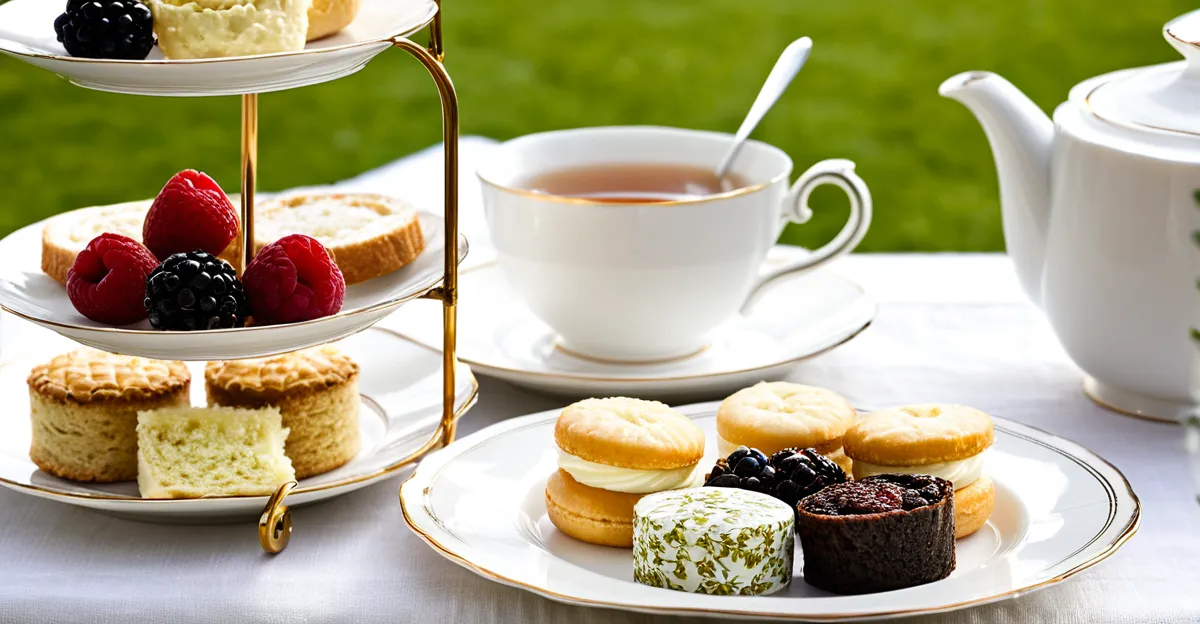Essential Elements of a Traditional British Afternoon Tea
Delving into the afternoon tea essentials unravels a cherished British tradition rich in culture and elegance. Beyond a simple meal, a traditional British afternoon tea spread is a ritual blending taste and social grace. The heart of an authentic tea menu revolves around a balanced combination of light dishes designed to delight both eye and palate.
A quintessential traditional British tea spread features dainty finger sandwiches, freshly baked scones, and an assortment of exquisite cakes. Sandwiches often include classic fillings such as cucumber and smoked salmon, offering savory notes, while the scones, served warm, are paired with clotted cream and jam to create a luxurious contrast. Cakes, delicate and appropriately sized, bring sweetness without overwhelming, rounding off the experience.
Topic to read : What are the steps to preparing an authentic bubble and squeak?
This structure follows an unhurried rhythm, inviting diners to savor each component. The meal’s order typically moves from savory sandwiches to warm scones and culminates in indulgent cakes, all carefully accompanied by a pot of freshly brewed tea. Understanding these afternoon tea essentials sets the foundation for recreating this timeless British custom at home or appreciating it fully when experienced in its traditional setting.
Preparing the Perfect Finger Sandwiches
Carefully crafted, visually inviting
In parallel : How can you infuse contemporary flavors into a classic shepherd’s pie?
A traditional British tea spread depends heavily on finger sandwiches, the unsung heroes of the afternoon tea essentials. These sandwiches must be delicate and precisely made. Classic fillings such as cucumber, egg mayonnaise, smoked salmon, and ham with mustard are cornerstone choices, offering a balanced variety of flavors to please diverse palates.
The bread, typically white or brown, should be sliced thinly with crusts removed, creating neat rectangles or triangles suited for dainty handling. Precision in cutting ensures uniformity, enhancing the sandwich’s appeal. Traditional tea sandwiches prioritize softness and subtle flavor, complementing the tea without overwhelming.
Equally important is the arrangement for serving. Presenting the sandwiches on a tiered stand or a decorative plate allows guests to appreciate each variation and eases selection during the meal. This careful attention to detail in preparing and serving finger sandwiches reflects the elevated experience expected in an authentic tea menu. Mastery of these sandwiches is essential to capturing the spirit of the afternoon tea tradition.
Baking and Serving Classic Scones
Baking the perfect foundation for indulgence
An essential component of the afternoon tea essentials is mastering a classic scones recipe that delivers light, fluffy results. Traditional scones rely on simple ingredients: self-raising flour, butter, sugar, milk, and sometimes eggs. The key is handling the dough gently to avoid overworking, which keeps the texture tender rather than dense.
To achieve the iconic rise, chill the dough before lightly cutting into rounds, ensuring edges are clean to encourage an even lift. Baking at a high temperature quickly forms a golden crust while maintaining a soft interior. Timing is critical—overbaking risks dryness, underbaking leaves doughy centers.
Serving scones warm is vital. They are traditionally paired with a generous spread of clotted cream and preserves, typically strawberry jam. The order of application often sparks debate, but an authentic tea menu embraces both ways. This combination creates a harmonious blend of richness and sweetness that complements the other components of a traditional British tea spread.
When plated, warm scones alongside clotted cream and jam enhance the ritual’s charm, inviting guests to savor a critical part of the British afternoon tea experience.
Creating a Selection of Classic Afternoon Tea Cakes and Pastries
Delight your guests with an authentic tea menu by including a variety of British cakes and afternoon tea pastries, which are vital to a traditional British tea spread. Signature cakes such as the Victoria sponge—a light, airy sponge filled with jam and cream—offer subtle sweetness that perfectly balances the savory elements. The Battenberg, with its distinctive checkered pattern and marzipan coating, adds visual charm and variety. Fruit tartlets introduce a fresh, tangy contrast, rounding out the dessert selection.
Portion size is key: cakes and pastries should be small and delicate, encouraging guests to sample multiple items without feeling overwhelmed. Presenting these treats on tiered stands enhances the meal’s elegance, showcasing the vibrant assortment.
Incorporating seasonal or regional specialties reflects authenticity, such as adding lemon drizzle cake in summer or rich mince pies during winter months. This attention to variety and presentation elevates the afternoon tea essentials, creating a balanced and memorable experience that honors the tradition of the traditional British tea spread.
Choosing and Brewing the Right Tea
Selecting the right tea varieties is crucial for an authentic tea menu and a truly memorable traditional British tea spread. Classic choices include Earl Grey, Assam, and Darjeeling—each offering distinct aromas and flavors to complement the food. Earl Grey is prized for its fragrant bergamot, Assam provides a robust, malty profile, and Darjeeling delivers a delicate, floral character.
The best teas for afternoon tea require precise brewing. Water should be freshly boiled, with black teas steeped for about 3-5 minutes; oversteeping can lead to bitterness, diminishing the enjoyment of afternoon tea essentials. Serving tea in pre-warmed pots preserves temperature, enhancing flavor extraction and presentation.
Offering alternative teas such as herbal or decaffeinated varieties ensures inclusivity for guests with different preferences. These options broaden the experience without disrupting the traditional flow.
With careful attention to brewing and selection, the tea elevates the meal, tying together the delicacies of finger sandwiches, scones, and cakes into a harmonious, refined traditional British tea spread.
Mastering Afternoon Tea Etiquette and Presentation
Refining the ritual to enhance enjoyment
Understanding afternoon tea etiquette elevates the experience of a traditional British tea spread beyond its delightful flavors. Guests typically begin by allowing the host to pour tea, dipping the tea bag or infuser gently while ensuring the teacup handle rests comfortably on the right. Cups are sipped quietly without clinking; stirring is done with a slight back-and-forth motion to avoid noise.
The order of courses follows tradition: start with finger sandwiches, then warm scones with clotted cream and jam, and finally, the assortment of cakes and pastries. This progression balances savory and sweet while respecting the unhurried pace central to an authentic tea menu.
Presentation plays a key role. Use tiered stands to showcase the variety of sandwiches, scones, and pastries, creating an inviting, elegant display. Coordinated crockery and polished cutlery contribute to an atmosphere of sophistication. Napkins folded neatly beside the plate and small spoons for jam maintain tidiness.
Overall, mastering serving and presentation customs ensures guests not only taste but truly appreciate the timeless charm of British afternoon tea.










